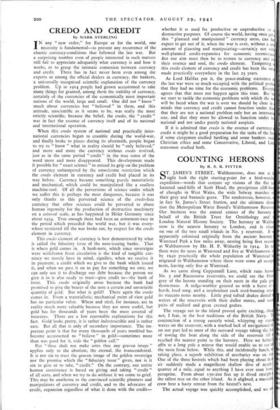CREDO AND CREDIT
By MARK STERLING
IN any " new order," for Europe or for the world, one necessity is fundamental—to prevent any recurrence of the chaotic currency-conditions that followed the last war. But a surprising number even of people interested in such matters still fail to appreciate adequately what currency is and how it works, or to grasp the intimate connexion between currency and credit. There has in fact never been even among the experts or among the official dealers in currency, the bankers, a universally recognised scientific explanation of the currency problem. Up to 1914 people had grown accustomed to take many things for granted, among them the stability of currency, certainly of the currencies of the economically most important nations of the world, large and small. One did not " know " much about currencies but " believed " in them, and this attitude, unscientific as it seems to be, was really the most strictly scientific, because of belief, the credo, the " credit " was in fact the essence of currency itself and of its national and international operation.
When this credo system of national and practically inter- national currencies began to crumble during the world-war, and finally broke to pieces during its aftermath, people began to try to " know " what in reality should be " only believed," and more and more the currency without credo evolved, just as in the same period " credit" in the true sense of the word more and more disappeared. This development made it possible for " exact science " to extend its grip on the problem of currency unhampered by the unwelcome restriction which the credo element in currency and credit had placed in its way before. Currency became something purely materialistic and mechanical, which could be manipulated like a soulless machine-tool. Of all the perversions of science under which we suffer this is perhaps the most dangerous, because it was only thanks to this perverted science of the credo-free currency that other sciences could be perverted to abuse human ingenuity for the production of destructive machinery on a colossal scale, as has happened in Hitler Germany since about i934. True enough there had been an armament-race in the period which preceded the world war, but it was every- where restricted till the war broke out, by respect for the credo element in currency.
This credo element, of currency is best demonstrated by what is called the fiduciary issue of the note-issuing banks. That is where gold comes in. A bank-note, which since sovereigns were withdrawn from circulation is the kind of tangible cur- rency we mostly have in mind, signifies, when we receive it in payment, a credit which we give to the bank which issued it, and when we pass it on to pay for something we owe, we can only use it to discharge our debt because the person we give it to is also ready to trust—give credit to—the bank of issue. This credo originally arose because the bank had promised to give the bearer of the note a certain and unvariable quantity of gold. But what is gold? There again the credo comes in. From a materialistic, mechanical point of view gold has no particular value. Wheat and steel, for instance, are in reality much more valuable because they are more useful, but gold has for thousands of years been the most coveted of treasures. There are a few reasonable explanations for this fact. Gold looks pretty, it is rather indestructible and is rather rare. But all that is only of secondary importance. The im- portant point is that for many thousands of years mankind has become accustomed to " believe " in gold—sometimes more than was good for it, vide the " golden calf."
But " thou shalt not make unto thee any graven image " applies only to the absolute, the eternal, the transcendental. It is not sin to trust the graven image of the golden sovereign nor the promise which the " fiduciary issue " gives, nor is it sin to give or to take, " credit." On the contrary, our entire human coexistence is based on giving and taking " credit " of all sorts, and when we try to do without it we come to grief. This may be anathema to the convinced scientific planners and manipulators of currency and credit, and to the advocates of credit, expansion regardless of what it done with the credit— whether it is used for productive or unproductive or destructive purposes. Of course the world, having once got this " planned and manipulated " currency mess, can expect to get out of it, when the war is over, without a ce amount of planning and manipulating—certainly not wi well-planned credit-expansion for economic reconstruc But our aim must then be to restore to currency and c their essence and soul, the credo element. Tampering this credo element of currency and credit has been the iniss made practically everywhere in the last 25 years.
As Lord Halifax put it, the peace-making statesmen the last war were so much occupied with the political probl that they had no time for the economic problems. Every agrees that that must not happen again this time. But u we start to tackle the economic problems with which the will be faced when the war is over we should be clear in minds that currency and credit cannot function 'under du that they are not a national problem only but an internal one, and that they must be allowed to function under in national and not under purely national auspices.
If it is admitted that credo is the essence of currency credit it might be a good preparation for the tasks of the fu if some clergymen studied banking and some bankers stu Christian ethics and some Conservative, Liberal, and Lab statesmen studied both.


































 Previous page
Previous page